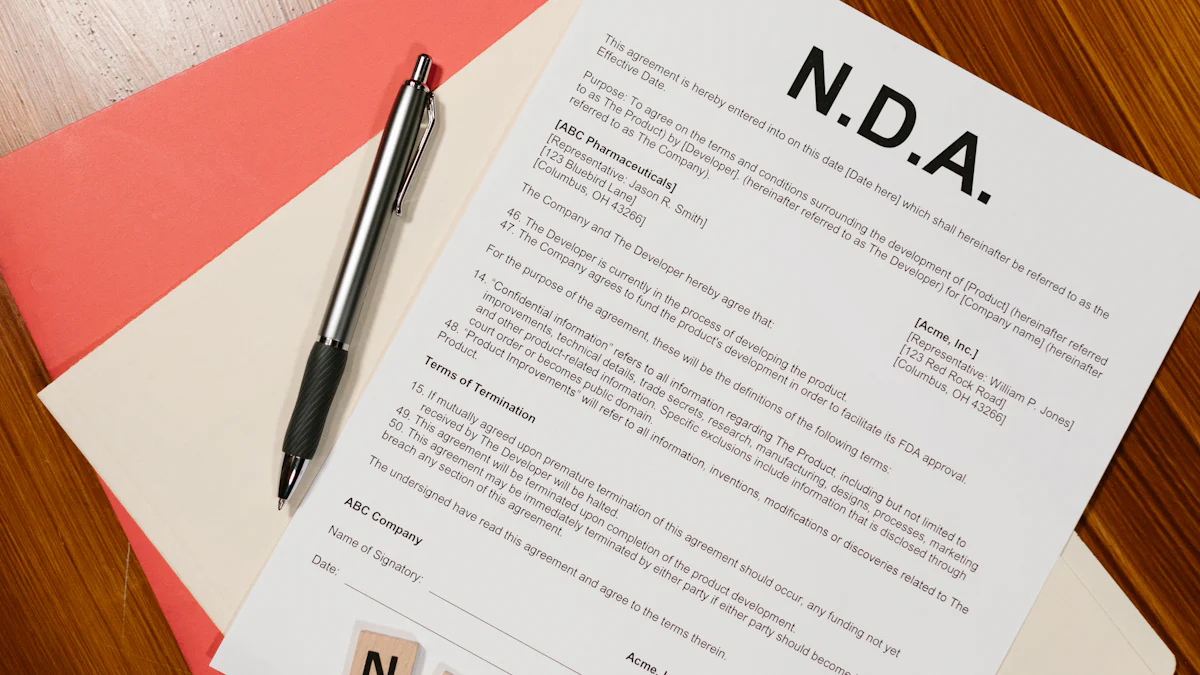Understanding Mutual Non-Disclosure Agreements in California

Overview of California MNDA
Mutual Non-Disclosure Agreements (MNDAs) in California play a vital role in protecting sensitive information. Whether it's business strategies, proprietary technologies, or trade secrets, MNDAs provide a legal framework for safeguarding confidential data shared between parties. In the competitive business landscape of California, where innovation and intellectual property are highly valued, having a robust mutual non-disclosure agreement is essential for fostering trust and collaboration while ensuring the security of proprietary information.
Confidentiality is paramount: In California, where innovation thrives, safeguarding sensitive information through MNDAs is crucial for maintaining a competitive edge.
Enforceability of NDAs in California
Legal Framework in California
In California, the legal framework surrounding non-disclosure agreements (NDAs) is governed by specific state laws that outline the parameters for enforceability. These laws dictate the requirements and provisions that must be met for an NDA to hold up in a court of law. Understanding the nuances of California's legal framework is essential when drafting and executing mutual non-disclosure agreements. It's crucial to ensure that all elements of an NDA align with the state's legal requirements to maximize enforceability.
Court Interpretations
Court precedents in California play a significant role in shaping the enforceability of NDAs. Legal decisions and interpretations made by courts establish guidelines for what constitutes a valid and enforceable non-disclosure agreement. Factors such as the clarity of language, the scope of confidential information, and the obligations of involved parties are carefully scrutinized based on court interpretations. These precedents provide valuable insights into how NDAs are evaluated within the context of California law, influencing their effectiveness in safeguarding sensitive information.
By staying informed about both the legal framework and court interpretations, individuals and businesses can craft robust mutual non-disclosure agreements that adhere to California's standards while effectively protecting confidential information.
Key Elements of a California MNDA
Scope of Confidential Information
When crafting a Mutual Non-Disclosure Agreement (MNDA) in California, it is essential to distinctly define the scope of confidential information. This involves outlining what constitutes confidential data and specifying the inclusions and exclusions within the agreement. Clearly delineating the confidential information helps to avoid ambiguity and ensures that both parties are aligned on what is considered sensitive and proprietary.
In a California MNDA, the scope of confidential information typically encompasses trade secrets, financial data, customer lists, product designs, business strategies, and any other proprietary information relevant to the parties involved. Conversely, exclusions may include information that is already publicly available or becomes public through no fault of either party.
Clarity is key: Defining the scope of confidential information with precision minimizes the risk of misunderstandings and disputes regarding what should be kept confidential under the MNDA.
Obligations of Parties
The obligations of parties within a California MNDA revolve around their responsibilities in safeguarding and using the disclosed confidential information. Both parties are bound by a duty to maintain confidentiality and are prohibited from disclosing or misusing the sensitive data shared during their engagement. These obligations extend beyond the duration of the agreement and require diligent efforts to protect the disclosed information from unauthorized access or use.
Additionally, parties are often required to implement reasonable security measures to prevent unauthorized disclosure or access to confidential information. This can include measures such as password protection for electronic files, restricted physical access to documents, and other appropriate safeguards based on the nature of the disclosed information.
By clearly outlining these obligations within a California MNDA, all involved parties can understand their roles in preserving confidentiality while fostering an environment conducive to open communication and collaboration.
Tips for Writing an Effective MNDA in California
When creating a mutual NDA in California, it is essential to pay close attention to the following tips to ensure its effectiveness and enforceability.
Clarity and Specificity
Importance of Clear and Specific Language: Utilizing clear and specific language in an MNDA is crucial for avoiding misunderstandings and legal disputes. Clearly defining the confidential information, obligations of the parties, and the scope of the agreement helps in minimizing ambiguity.
Avoiding Ambiguous Terms: Ambiguity can lead to misinterpretation of the agreement's terms. It's important to avoid using vague or ambiguous language that could create confusion about the rights and responsibilities of each party involved.
Clarity is Key: A well-crafted MNDA with clear and specific language provides a solid foundation for enforcing confidentiality obligations and protecting sensitive information effectively.
Legal Review and Consultation
Seeking Legal Advice When Drafting an MNDA: Consulting with legal professionals who specialize in contract law ensures that the mutual NDA complies with California's legal requirements. Legal experts can provide valuable insights into drafting a reciprocal nondisclosure agreement that aligns with state laws while safeguarding confidential information effectively.
Importance of Thorough Review and Consultation: Thoroughly reviewing the MNDA with all involved parties before finalizing it is essential. This process allows for any necessary revisions or clarifications to be made, ensuring that the agreement reflects the intentions of all parties accurately.
By adhering to these tips, individuals and businesses can create robust mutual NDAs that provide comprehensive protection for their sensitive information while fostering trustworthy relationships.
Sample California MNDA and Explanatory Notes
Sample MNDA Template
In order to provide a clear understanding of a California Mutual Non-Disclosure Agreement (MNDA), a sample template is presented below. This template outlines key clauses and sections that are essential for creating a comprehensive and enforceable MNDA in California.
Sample California MNDA Template
Mutual Non-Disclosure Agreement (MNDA)
This Mutual Non-Disclosure Agreement ("Agreement") is entered into as of [Date], by and between [Party A] and [Party B], collectively referred to as the "Parties."
1. Definition of Confidential Information:
- The Parties acknowledge that "Confidential Information" refers to any data or information, oral or written, disclosed by one Party to the other that is identified as confidential at the time of disclosure.
2. Obligations of Parties:
- Both Parties agree to maintain the confidentiality of the disclosed information and use it solely for the purpose outlined in this Agreement.
3. Exclusions from Confidential Information:
- Information that is independently developed by either Party without reference to the other, publicly available information, or information rightfully obtained from a third party without confidentiality obligations shall not be considered Confidential Information under this Agreement.
4. Duration and Termination:
- This Agreement shall remain in effect for [Duration] from the date of signing. Upon termination, both Parties shall promptly return or destroy all materials containing Confidential Information.
5. Governing Law:
- This Agreement shall be governed by and construed in accordance with the laws of the State of California.
IN WITNESS WHEREOF, the Parties have executed this Agreement as of the date first above written.
[Signature Party A] [Signature Party B]
[Printed Name Party A] [Printed Name Party B]
Guidance for Completing an MNDA
Completing a Mutual Non-Disclosure Agreement (MNDA) requires attention to detail and clarity to ensure its effectiveness in safeguarding confidential information. Here are step-by-step instructions for completing an MNDA:
Identify Parties: Clearly identify all parties involved in the agreement, including their legal names and official titles if applicable.
Define Confidential Information: Provide a precise definition of what constitutes confidential information within the context of the agreement.
Specify Obligations: Outline specific obligations related to maintaining confidentiality, permitted uses of disclosed information, and restrictions on disclosure or misuse.
Include Duration and Termination Clause: Define the duration for which the agreement remains valid and specify conditions for termination.
Seek Legal Review: It's advisable to seek legal review before finalizing an MNDA to ensure compliance with California laws and maximize enforceability.
By following these guidelines, individuals can effectively complete a California MNDA while ensuring thorough protection for their sensitive information.
Insights on California MNDA
In conclusion, comprehending the enforceability and essential elements of a Mutual Non-Disclosure Agreement (MNDA) in California is paramount for effectively safeguarding sensitive information. By understanding the legal framework, court interpretations, and key components of an MNDA, individuals and businesses can establish robust agreements that adhere to California's standards while providing comprehensive protection for confidential data.
Fostering Trust and Collaboration: A well-crafted MNDA not only safeguards sensitive information but also fosters trust and collaboration between parties involved.
To maximize the effectiveness of an MNDA in California, it is advisable to seek legal guidance during the drafting process to ensure compliance with state laws.
Clear and specific language, along with precise definitions of confidential information, are fundamental aspects that contribute to the enforceability of an MNDA in California.
By staying informed about the intricacies of mutual non-disclosure agreements in California, entities can navigate business relationships with confidence, knowing that their proprietary information is adequately protected.
See Also
Comprehending Non-Disclosure Contracts for Employees in Minnesota
Comprehending Non-Competition Contracts and NDAs in New York Legal System 2024
The Procedure for Creating Non-Disclosure Contracts in Delaware
Tips for Crafting a Non-Disclosure Contract in Montana
Comprehending Non-Competition Contracts in Michigan: Legal Obligations and Implementation

